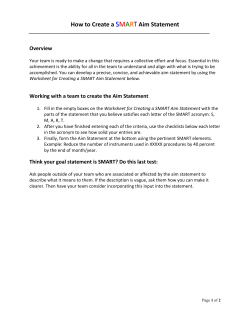
I W B NTERACTIVE
INTERACTIVE WHITE BOARDS DO THEY POSITIVELY IMPACT EDUCATION? By: Sheri Cooper & Lauren Townsend ADVANTAGES OF IWBS ADVANTAGES FOR STUDENTS Increased Participation Increased Motivation Opportunity to delve into complex and abstract subjects ADVANTAGES FOR TEACHERS Flexibility Multiple Resources Reaches multiple and diverse students DISADVANTAGES OF IWBS DISADVANTAGES FOR STUDENTS Quickly lose appeal Less time on content One note lessons DISADVANTAGES FOR TEACHERS Technical Issues Teacher Training Shifts attention from student to technology EFFECTIVENESS OF SMART BOARD TECHNOLOGY EFFECTIVENESS OF SMART BOARD TECHNOLOGY As a tool for non-linear learning By accessing text and media Ability to move back and forth among pages Ability to present the same information in different ways EFFECTIVENESS OF SMART BOARD TECHNOLOGY Combines the benefits of interactive computer use with group learning Internet access Videos Large screen EFFECTIVENESS OF SMART BOARD TECHNOLOGY As a tool for multi-modal teaching Descriptive Experimental Mathematical Figurative Kinesthetic EFFECTIVENESS OF SMART BOARD TECHNOLOGY As a tool for teaching children with disabilities Manipulatives Auditory and Visual Cues Interactive video Various assessment strategies EFFECTIVE USE OF SMART BOARD TECHNOLOGY EFFECTIVE USE OF SMART BOARD TECHNOLOGY Must have adequate training and time to find appropriate software Provide incentives to increase IWB skills Vendor training In-service training Tutorials Cooperative learning among teachers EFFECTIVE USE OF SMART BOARD TECHNOLOGY must be an integral part of the lesson, not something tacked on to be fun Create lessons on the IWB Use features in the software REFERENCES Akbas, O., & Pektas, H. M. (2011). The effects of using an interactive whiteboard on the academic achievement of university students. Asia-Pacific Forum on Science Learning and Teaching, 12(2) Armstrong, V., Barnes, S., Sutherland, R., Curran, S., Mills, S., & Thompson, I. (2005). Collaborative research methodology for investigating teaching and learning: the use of interactive whiteboard technology. Educational Review, 57(4), 457-469. doi:10.1080/00131910500279551 Betteney, M. (2009). Interactive white boards. English 4--11, (35), 3-5. Blau, I. (2011). Teachers for "Smart Classrooms": The Extent of Implementation of an Interactive Whiteboard-based Professional Development Program on Elementary Teachers' Instructional Practices. Interdisciplinary Journal Of E-Learning & Learning Objects, 7275-289. Campbell, M. L., & Mechling, L. C. (2009). Small Group Computer-Assisted Instruction With SMART Board Technology : An Investigation of Observational and Incidental Learning of Nontarget Information. Remedial & Special Education, 30(1), 47-57. Giles, R. M., & Shaw, E. L. (2011). SMART boards ROCK! Science and Children, 49(4), 36-37. Harden-Thew, K. (2012). Transition to school, success and an interactive whiteboard. Practically Primary, 17(1), 34-36. How to afford interactive whiteboards. (2011). Technology & Learning, 31(8), 44-46. Jang, S., & Tsai, M. (2012). Exploring the TPACK of Taiwanese elementary mathematics and science teachers with respect to use of interactive whiteboards. Computers & Education, 59(2), 327- 338. doi:10.1016/j.compedu.2012.02.003 Manny-Ikan, E., Tikochinski, T. B., Zorman, R., & Dagan, O. (2011). Using the interactive white board in teaching and learning - an evaluation of the SMART CLASSROOM pilot project. Interdisciplinary Journal of E-Learning & Learning Objects, 7, 249-273. McNamara-Cabral, M. (2012). Idea bank: How a smart board changed my teaching. Music Educators Journal, 98(3), 26-27. doi: 10.1177/0027432112439669 Murcia, K. (2010). Multi-modal representations in primary science: What's offered by interactive whiteboard technology. Teaching Science: The Journal Of The Australian Science Teachers Association, 56(1), 23-29. Şad, S. N., nihat.sad@inonu.edu.tr. (2012). An attitude scale for smart board use in education: Validity and reliability studies. Computers & Education, 58(3), 900-907. doi: 10.1016/j.compedu.2011.10.017 Şad, S., & Özhan, U. (2012). Honeymoon with IWBs: A qualitative insight in primary students' views on instruction with interactive whiteboard. Computers & Education, 59(4), 1184-1191. doi:10.1016/j.compedu.2012.05.010 Türel, Y., & Johnson, T. E. (2012). Teachers' Belief and Use of Interactive Whiteboards for Teaching and Learning. Journal Of Educational Technology & Society, 15(1), 381394. Whitby, P. S., Leininger, M. L., & Grillo, K. (2012). Tips for Using Interactive Whiteboards to Increase Participation of Students With Disabilities. Teaching Exceptional Children, 44(6), 50-57. Xin, J. F., & Sutman, F. X. (2011). Using the smart board in teaching social stories to students with autism. Teaching Exceptional Children, 43(4), 18-24.
© Copyright 2025





















